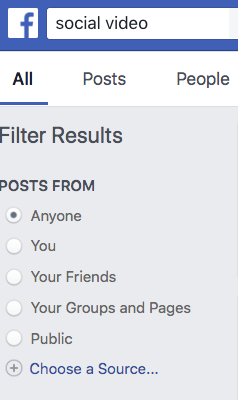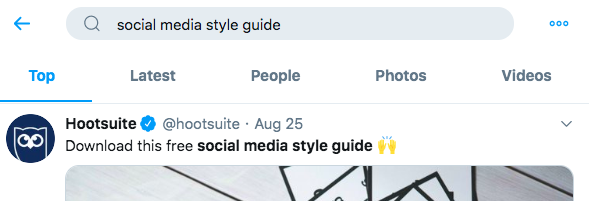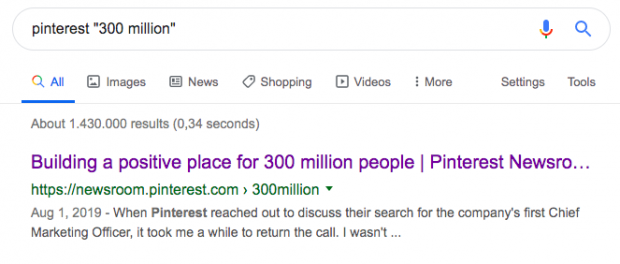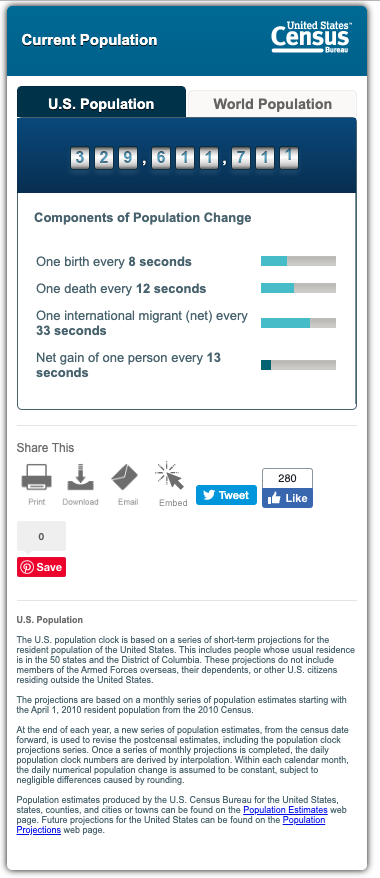Struggling to Find That Stat? Research Tips for Social Media Marketers
Content may be king, but poorly researched content can make you look more like a joker.
Great social media research skills can help boost your reputation as an expert in your field. But it’s a wild world of information out there. It can be tricky to find the precise data you’re looking for from a credible source.
Even if you do strike research gold, you can still go wrong by using statistics incorrectly. This is something even professional journalists can struggle with. So, what’s an aspiring content marketer to do?
In this guide, you’ll learn seven effective ways to conduct social media research for professional, accurate content.
Bonus: Download a free guide that reveals how to increase social media engagement with better audience research, sharper customer targeting, and Hootsuite’s easy-to-use social media software.
Online research tools
Google, of course, is an online researcher’s best friend. But it can also be your worst enemy, sucking you into time-wasting dead ends as you hunt for information. It can also lead you astray, since it returns information unfiltered for credibility. Remember: Just because you found a “fact” on the internet doesn’t make it true.
First, let’s talk about some advanced search techniques to target your research efforts. These will help reduce the amount of time you spend searching through irrelevant information.
1. Use Google search operators and advanced search
Google search operators are simply text cues to help Google understand exactly what you’re looking for. They narrow down the potential matches to your search, reducing irrelevant information. Some of the most useful include:
Quotation marks (“”)
Placing a phrase in quotation marks tells Google that you’re searching for that specific phrase. Without the quotes, Google will search for any combination of the words.
For example, try searching “online research strategies”. The search will return articles (like this one) that contain that specific phrase. If you search without the quotation marks, you’re more likely to get content about research in general, rather than specific online tips.
Asterisk (*)
An asterisk acts as a wildcard, allowing Google to fill in the blanks.
For example, maybe you’re looking for a quote from Shakespeare, but you can only remember some of the words. You could search “to * own self be true”.
Site:
This operator allows you to search only the results from a specific website. This is particularly helpful if a website does not have its own search field.
For example, you could use it to search the Hootsuite website straight from Google. To learn how to add a stream to your Hootsuite dashboard, you could type site:Hootsuite.com “add stream” in the Google search bar. Be sure not to insert a space after the colon, or this won’t work.
Number range (..)
Placing two periods between numbers instructs Google to search for any numbers within that range. This can be especially useful when searching for results that include specific dates.
For example, you could search Space Shuttle 1981..2011. You would get Space Shuttle results that mention any dates within that number range.
Related:
This handy search operator will bring up sites related to any site you specify. This can be very handy for competitor research, or for finding potential influencers and thought leaders in your niche.
For example, try searching your own site with this operator to see what sites Google thinks are related to yours. Type related:[yoursite].com. Make sure not to add a space after the colon.
You can also use Google’s advanced search page to narrow your results. You can filter by language, region, file type, and more, without having to memorize any search operators. Several of these tools are also available on the main search results page, under the Tools tab.
2. Use Boolean search operators
Boolean search is named after George Boole. He was a 19th-century British mathematician who developed much of the logic that search engines now use to find what we’re looking for online.
Boolean search terms can help target your results in searches beyond the search engines. For example, you can use them to search a specific website, social network, or online database. Here are some common Boolean search operators.
AND
Using AND between two search terms indicates that you only want results that include both search terms. This can be particularly helpful when you’re looking for statistics that compare two or more things.
For example, searching Instagram AND Facebook AND TikTok reveals only sources that mention all three of these social networks. Keep in mind that Google automatically treats all searches as AND searches.
OR
Using OR between search terms indicates that you want to search for any of the terms rather than all of them.
Following on the previous example, searching for Instagram OR Facebook OR TikTok will return:
- sources that mention only Instagram
- sources that mention only Facebook
- sources that mention only TikTok
- and sources that mention any combination of these networks
But OR is most helpful if there are two different ways of referring to the same thing. For example, maybe you’re searching for something that has different names in different places. If, say, you are conducting research about decor for small apartments, you could search “decor for small” apartment OR flat.
Hyphen (-)
Using a hyphen (or minus sign) before a search term eliminates results that include that term. This can be particularly helpful when a word has multiple meanings, and you only want results for one of those meanings.
So, searching Instagram -Facebook returns sources that mention Instagram but not its parent company, Facebook.
But this might come in more handy if, say, you were searching for information on Amazon, and you only wanted results about the company, not the rainforest. You could search Amazon -rainforest -Brazil.
Bonus: Download a free guide that reveals how to increase social media engagement with better audience research, sharper customer targeting, and Hootsuite’s easy-to-use social media software.
Get the free guide right now!Social media research tips and best practices
3. Filter results by date
While information doesn’t come with a clear best-before date, it’s only useful if it’s current.
When searching for information in Google, go to Tools. Then click on Any time to bring up a drop-down menu that allows you to select a specific date range for your search.

You can also choose to search only for information from the last hour, day, week, month, or year.
4. Search for embeddable social media posts
Sometimes the best way to quote a source or provide an example is to embed the original social post in your content, like this:
Hey Siri, is voice search on the rise? Click this link to find out: http://ow.ly/VSc750vGkEo
Posted by Hootsuite on Monday, August 26, 2019
After all, there’s no chance of misquoting when you’re directly sharing the original source.
But it’s still important to stick with credible sources. Just as not every “fact” you find in Google is true, not every post you find on social channels comes from someone who knows what they’re talking about.
Search Facebook
Facebook search allows you to find relevant content on Facebook.
Enter your search terms in the search bar at the top of your Facebook page. You can then use the filters and options to find more specific results. You can filter by source, location, and date, and choose from posts, photos, videos, and more.

Keep in mind that you can only embed posts that are set to be publicly visible.
Search Twitter
The Twitter search bar works with Boolean search terms. That means you can use the information above to customize your research on Twitter. You can then use the tabs to filter by the most popular (Top) or most recent posts, or to specifically look for photos or videos.

There’s also a somewhat tricky-to-find advanced Twitter search page. It allows you to filter your search by user, date, search terms, and language. You can also use all of these in combination to laser-target your search.
Search Instagram
Instagram search only considers names, usernames, locations, and hashtags, so it can be harder to find relevant statistics here. That said, it’s worth a shot, since you might find infographics and other visual data.
Instagram can especially useful if you’re looking for information coming out of a conference or event, since this will likely include a known hashtag or location.

Type your search term into the search bar, and Instagram will suggest relevant hashtags, users, and locations.
Search with Hootsuite
You can use Hootsuite to search for conversations about particular topics on Twitter, Facebook, LinkedIn, and Instagram.
You can then set up a Hootsuite stream to keep tabs on what authoritative sources are saying on social media. That way, you’ll always have a prescreened “go file” ready when you need new details.
5. Find the original source
When you begin your research online, you will likely come across a lot of news articles or compilations of statistics. These can be a great starting point for your social media research, but you need to dig deeper to find the original source.
For example, this CNN article says that Pinterest surpassed 300 million monthly active users in the second quarter of 2019. But CNN is not the source of the information, so you need to keep going to find the original source to cite yourself.
The CNN article cites Pinterest as the source of the information (“Pinterest reported”), but does not provide a direct link. Still, it’s pretty easy to find. Just Google “Pinterest” “300 million” and Pinterest’s original announcement appears as the first search result.

You now have an original source to cite directly in your own article. This would also be a great place to use the site: Boolean operator to find results directly from the company’s website.
6. Use consistently reliable sources
With so much information out there, it’s important to start building a list of credible sources in your industry. Here are some good places to start.
Company web properties
When looking for statistics or other information about a company, the best place to start is the company itself. Good places to search include the company’s:
- blog
- news or media relations page
- about page.
For example, you can learn from the Hootsuite newsroom that there are more than 18 million Hootsuite users. This is an original statistic straight from the source.
Pages that showcase the company’s advertising options can also be a good source of data, since user numbers are of particular interest to potential advertisers. For example, Facebook’s Ads page reveals that 1.6 billion people are connected to a small business on Facebook.
For public companies, the investor relations page is usually the most up-to-date source of user numbers and revenue figures.
For example, check out the “Selected Company Metrics and Financials” document on Twitter’s Investor Relations page. Among other statistics, you can learn that Twitter had 139 million monetizable daily active users as of the end of Q2 2019.
Company social profiles
Companies often share statistics or announcements in their social profiles. These are great for embedding.
Twitter even has an account dedicated to sharing statistics about the company itself and how people use the platform. You can find some pretty obscure statistics here that make for interesting research.
Who did you think would take the throne? These were the most Tweeted about #GameOfThrones characters throughout the final season:#AryaStark #DaenerysTargaryen #Cersei #JonSnow #SansaStark
— Twitter Data (@TwitterData) May 20, 2019
Government sources
Government statistics agencies and census results provide lots of useful and reliable information about a wide range of topics.
For example, the U.S. Census Bureau has a population clock showing up-to-the-minute figures for the U.S. and world population.

Research organizations
Research companies and organizations that produce regular reports are also a great source of data.
Keep an eye on the sources that are regularly cited in your industry to get a sense of the major players. Those relevant to you will vary, but Forrester, comScore, and the Pew Research Center are great places to start.
Hootsuite and We Are Social Digital Reports
The annual reports and quarterly updates that researcher Simon Kemp creates for Hootsuite and We Are Social are packed with useful statistics about Internet and social media use.
The Global State of Digital in 2019
Read the #Digitalin2019 report from Hootsuite and Simon Kemp of We Are Social!In this report, you'll find data about the changing landscape in social, mobile, and e-commerce from every country in the world ???? http://ow.ly/M83j50lY9vt
Posted by Hootsuite on Friday, February 22, 2019
7. Use research statistics appropriately
Working with statistics is challenging even for professional journalists. It’s definitely an area to watch out for when you’re researching.
Percentages can be particularly tricky. For example, the percentage of women who use Facebook (77%) is a very different statistic from the percentage of Facebook users who are women (43%).
But these statistics often get mixed up. For instance, you can learn from our post on Facebook demographics that 79% of 30- to 49-year-olds have Facebook accounts. We got this statistic from a Pew Research Center report.
It’s a common mistake to flip statistics like this around, saying instead that 79% of Facebook users are aged 30 to 49.
In fact, some articles online do say this, linking back to the same Pew Research Report we cited. Some even add that 46% of Facebook users are over 65, another backwards statistic. The correct information is that 46% of people who are aged 65+ use Facebook.
Think about that for a moment: 79% plus 46% = 125%. Since “%” means “out of 100,” well, you see the problem.
If this all sounds a bit confusing, that’s because it is. That’s exactly why you need to make sure you truly understand what a statistic means before using it to back up a point or incorporating it into your content. This guide from the Centre for Investigative Journalism provides some good tips for working with statistics:
Incorporating all of these techniques will help you use the Web for effective research to build your credibility and support your content marketing strategy. When you use research and statistics right, your site becomes its own credible source of quality information for your followers and potential leads.
Use Hootsuite to research your social media audience and schedule posts to appear at the time they are most likely to be online. Try it free today.
The post Struggling to Find That Stat? Research Tips for Social Media Marketers appeared first on Hootsuite Social Media Management.
Categories
- 60% of the time… (1)
- A/B Testing (2)
- Ad placements (3)
- adops (4)
- adops vs sales (5)
- AdParlor 101 (43)
- adx (1)
- algorithm (1)
- Analysis (9)
- Apple (1)
- Audience (1)
- Augmented Reality (1)
- authenticity (1)
- Automation (1)
- Back to School (1)
- best practices (2)
- brand voice (1)
- branding (1)
- Build a Blog Community (12)
- Case Study (3)
- celebrate women (1)
- certification (1)
- Collections (1)
- Community (1)
- Conference News (1)
- conferences (1)
- content (1)
- content curation (1)
- content marketing (1)
- contests (1)
- Conversion Lift Test (1)
- Conversion testing (1)
- cost control (2)
- Creative (6)
- crisis (1)
- Curation (1)
- Custom Audience Targeting (4)
- Digital Advertising (2)
- Digital Marketing (6)
- DPA (1)
- Dynamic Ad Creative (1)
- dynamic product ads (1)
- E-Commerce (1)
- eCommerce (2)
- Ecosystem (1)
- email marketing (3)
- employee advocacy program (1)
- employee advocates (1)
- engineers (1)
- event marketing (1)
- event marketing strategy (1)
- events (1)
- Experiments (21)
- F8 (2)
- Facebook (64)
- Facebook Ad Split Testing (1)
- facebook ads (18)
- Facebook Ads How To (1)
- Facebook Advertising (30)
- Facebook Audience Network (1)
- Facebook Creative Platform Partners (1)
- facebook marketing (1)
- Facebook Marketing Partners (2)
- Facebook Optimizations (1)
- Facebook Posts (1)
- facebook stories (1)
- Facebook Updates (2)
- Facebook Video Ads (1)
- Facebook Watch (1)
- fbf (11)
- first impression takeover (5)
- fito (5)
- Fluent (1)
- Get Started With Wix Blog (1)
- Google (9)
- Google Ad Products (5)
- Google Analytics (1)
- Guest Post (1)
- Guides (32)
- Halloween (1)
- holiday marketing (1)
- Holiday Season Advertising (7)
- Holiday Shopping Season (4)
- Holiday Video Ads (1)
- holidays (4)
- Hootsuite How-To (3)
- Hootsuite Life (1)
- how to (5)
- How to get Instagram followers (1)
- How to get more Instagram followers (1)
- i don't understand a single thing he is or has been saying (1)
- if you need any proof that we're all just making it up (2)
- Incrementality (1)
- influencer marketing (1)
- Infographic (1)
- Instagram (39)
- Instagram Ads (11)
- Instagram advertising (8)
- Instagram best practices (1)
- Instagram followers (1)
- Instagram Partner (1)
- Instagram Stories (2)
- Instagram tips (1)
- Instagram Video Ads (2)
- invite (1)
- Landing Page (1)
- link shorteners (1)
- LinkedIn (22)
- LinkedIn Ads (2)
- LinkedIn Advertising (2)
- LinkedIn Stats (1)
- LinkedIn Targeting (5)
- Linkedin Usage (1)
- List (1)
- listening (2)
- Lists (3)
- Livestreaming (1)
- look no further than the new yorker store (2)
- lunch (1)
- Mac (1)
- macOS (1)
- Marketing to Millennials (2)
- mental health (1)
- metaverse (1)
- Mobile App Marketing (3)
- Monetizing Pinterest (2)
- Monetizing Social Media (2)
- Monthly Updates (10)
- Mothers Day (1)
- movies for social media managers (1)
- new releases (11)
- News (72)
- News & Events (13)
- no one knows what they're doing (2)
- OnlineShopping (2)
- or ari paparo (1)
- owly shortener (1)
- Paid Media (2)
- People-Based Marketing (3)
- performance marketing (5)
- Pinterest (34)
- Pinterest Ads (11)
- Pinterest Advertising (8)
- Pinterest how to (1)
- Pinterest Tag helper (5)
- Pinterest Targeting (6)
- platform health (1)
- Platform Updates (8)
- Press Release (2)
- product catalog (1)
- Productivity (10)
- Programmatic (3)
- quick work (1)
- Reddit (3)
- Reporting (1)
- Resources (34)
- ROI (1)
- rules (1)
- Seamless shopping (1)
- share of voice (1)
- Shoppable ads (4)
- Skills (28)
- SMB (1)
- SnapChat (28)
- SnapChat Ads (8)
- SnapChat Advertising (5)
- Social (169)
- social ads (1)
- Social Advertising (14)
- social customer service (1)
- Social Fresh Tips (1)
- Social Media (5)
- social media automation (1)
- social media content calendar (1)
- social media for events (1)
- social media management (2)
- Social Media Marketing (49)
- social media monitoring (1)
- Social Media News (4)
- social media statistics (1)
- social media tracking in google analytics (1)
- social media tutorial (2)
- Social Toolkit Podcast (1)
- Social Video (5)
- stories (1)
- Strategy (608)
- terms (1)
- Testing (2)
- there are times ive found myself talking to ari and even though none of the words he is using are new to me (1)
- they've done studies (1)
- this is also true of anytime i have to talk to developers (1)
- tiktok (8)
- tools (1)
- Topics & Trends (3)
- Trend (12)
- Twitter (15)
- Twitter Ads (5)
- Twitter Advertising (4)
- Uncategorised (9)
- Uncategorized (13)
- url shortener (1)
- url shorteners (1)
- vendor (2)
- video (10)
- Video Ads (7)
- Video Advertising (8)
- virtual conference (1)
- we're all just throwing mountains of shit at the wall and hoping the parts that stick don't smell too bad (2)
- web3 (1)
- where you can buy a baby onesie of a dog asking god for his testicles on it (2)
- yes i understand VAST and VPAID (1)
- yes that's the extent of the things i understand (1)
- YouTube (13)
- YouTube Ads (4)
- YouTube Advertising (9)
- YouTube Video Advertising (5)
